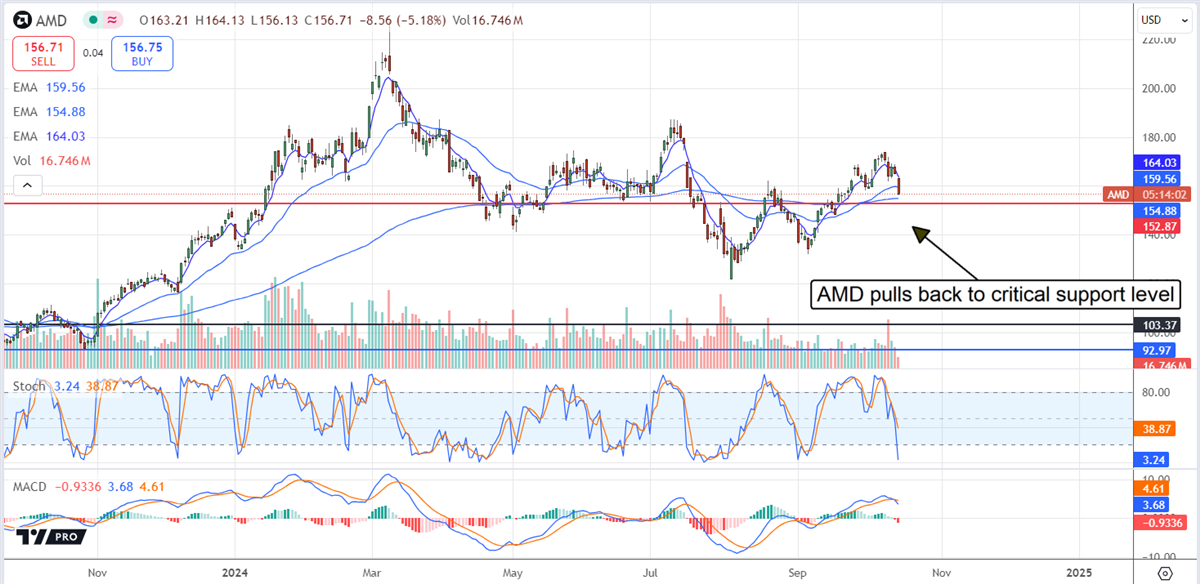Advanced Micro Devices AMD is making waves in the AI sector.
Historically, NVIDIA outshone the competition due to its early foothold but faces a formidable challenger in AMD. Despite NVIDIA’s stronghold on 95% of the AI data center market, AMD is steadily asserting dominance over a significant share. With an anticipated surge of over 1,000 basis points in market share growth, combined with industry-wide expansion, AMD sets the stage to boost revenue, earnings, and shareholder value.
Notably, the industry is in a phase of rapid acceleration. At a recent investor event, AMD’s CEO Lisa Su revised her projections, envisaging a striking 60% compound annual growth rate (CAGR) over the coming five years.
Even beyond corporate projections, the demand for AMD’s AI-centric chips is palpable. Major players such as Hewlett Packard Enterprises HPE, Meta Platforms META, and Oracle ORCL showcase a burgeoning appetite for these chips to fortify high-performance computing applications necessitating minimal latency. Oracle’s recent unveiling of a supercluster integrating over 16,000 MI300Xs utilizing AMD’s tool suite exemplifies the trend. Additionally, Hewlett Packard Enterprise is gearing up to deploy eight MI325X chips and two EPYC CPUs in its latest servers, the HPE Proliant XD685, catering to AI service providers and large-scale model developers.
The efficacy of AMD’s suite of tools cannot be overstated; the ROCm package, akin to NVIDIA’s CUDA, empowers programmers to leverage the GPU prowess for AI applications. While NVIDIA may have led the charge initially, AMD’s strategic positioning renders it primed to narrow the gap and deliver escalating outcomes, surpassing consensus projections and elevating shareholder value over the imminent quarters.
Setting the Bar Low: AMD’s Q3 Guidance Amidst 15% Growth Projections
AMD’s Q3 guidance presents a solid trajectory but proffers a modest benchmark to exceed. With a forecasted $6.71 billion in net sales indicating a 15% uptick – a pace accelerating from the prior quarter but trailing the industry’s growth momentum and AI counterparts – AMD’s growth narrative leans on the data center segment’s robust performance. This sector sustained triple-digit growth in Q2, a trend anticipated to continue into Q3, albeit balanced by a slowdown in the client segment and gaming sector normalization.
Furthermore, the data center, now constituting nearly half of the revenue in the year’s initial half, is poised for sustained contribution enhancements. Although gaming revenue may dip in Q3 compared to the previous year, the deceleration is expected to taper off, possibly transitioning into growth by 2025 and bolstering overall business dynamics.
Noteworthy risks on the horizon for AMD investors stem from potential government regulations, including US contemplation of export bans to curb AI proliferation in high-risk regions, warranting a cautious approach to global market penetration.
The guidance, irrespective of the growth projections and potential outperformance in Q3, stands poised to sway the market. The prevailing consensus hinting at another 15% revenue ascend for the year, coupled with expanding margins, may fall short of the burgeoning appetite for AMD products.
Among the prominent news highlights in the Q3 calendar is the debut of the Ryzen AI Pro 300 series chips, tailored to enhance Microsoft Copilot AI Assist. These chips, operating at a 40% swifter pace than the competition, promise up to 14% higher enterprise workload efficiency, presenting an enticing proposition for IT budgetary planners and business strategists. Additionally, the impending launch of the Turin EPYC data center CPUs poised to rival NVIDIA’s Blackwell scheduled for Q1 2025 hints at AMD’s relentless march towards parity and eventual dominance.
Analysts Watchful for AMD’s Q3 Disclosure as Potential Recovery Driver
Market analysts have been revising their outlook for AMD’s stock valuations, concurrently trimming earnings estimates. Since late 2023, the consensus has surged by over 40%, snowballing ahead of the Q3 earnings announcement, projecting an almost 20% upside from the current $160 threshold. Recent updates solidifying the targets post-Q2 results align the stock within the $180-$200 spectrum, resonating with market sentiment. A robust earnings report in Q3 has the potential to serve as a catalyst, propelling the market trajectory upwards.
The price dynamics surrounding AMD stock have been tepid post the October investor briefing and product disclosures. A perceptible market downturn, nearly 10% below the recent peak, may persist until the earnings unveil. The crucial support juncture near $152.50 appears imminent and could offer an attractive entry window for both traders and investors. If the support faltering persists and a lower nadir materializes, a descent to $140 becomes probable, with $120 not entirely off the table.

Market News and Data brought to you by Benzinga APIs

